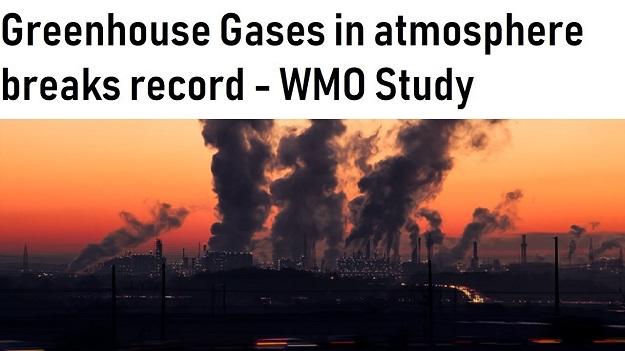
Q- which of the following gas is not green house gas
- A) CO2
- B) CO
- C) SO2
- D) NO2
- The levels of greenhouse gases in the atmosphere, the main driver of climate change, have hit a new record high, the UN said.
- Ahead of the COP 24 climate summit in Poland next month, top United Nations officials are again trying to raise the pressure on governments to meet the pledge of limiting warming to the less than two degrees Celsius, enshrined in the 2015 Paris accord.
- “Without rapid cuts in CO2 and other greenhouse gases, climate change will have increasingly destructive and irreversible impacts on life on Earth,”
- “Entire nations, ecosystems, peoples and ways of life could simply cease to exist,”
- US President Donald Trump, who pulled his government out of the Paris agreement, again on
- The Greenhouse Gas Bulletin, the UN weather agency’s annual flagship report, tracks the content of dangerous gases in the atmosphere since 1750.
- This year’s report, which covers data for 2017, puts the concentration of CO2 in the atmosphere at 405.5 parts per million (ppm).

-
- That is up from 403.3 ppm in 2016 and 400.1 ppm in 2015.
- “The last time the Earth experienced a comparable concentration of CO2 was 3-5 million years ago, when the temperature was 2-3°C warmer,”
- In addition to CO2, the UN agency also highlighted rising levels of methane, nitrous oxide and another powerful ozone depleting gas known as CFC-11.
- Emissions are the main factor that determines the amount of greenhouse gas levels, but concentration rates are a measure of what remains after a series of complex interactions between atmosphere, biosphere, lithosphere, cryosphere and the oceans.
- Roughly 25 percent of all emissions are currently absorbed by the oceans and biosphere—a term that accounts for all ecosystems on Earth. The lithosphere is the solid, outer part of the Earth, while the cyrosphere covers that part of the world covered by frozen water.
- The UN’s Intergovernmental Panel on Climate Change (IPCC) has said that in order to keep warming below 1.5 degrees Celsius, net CO2 emissions must be at net zero, meaning the amount being pumped into the atmosphere must equal the amount being removed, either though natural absorbtion or technological innovation.
- According to the UN, 17 of the 18 hottest years on record have occurred since 2001, while the cost of climate-related disasters in 2017 topped $500 billion (439 billion euros).





















 WhatsApp
WhatsApp